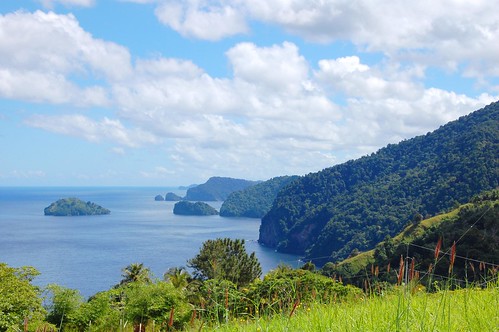
"Diamond Vale View" was taken from a hilltop and it depicts a typical tourist image where everything is blue and green. It is a compelling image free of modern elements.
An Eye of the Tropics is an informative narrative contradicting the notion of a tropical Caribbean. For me, it was eye opening to read about the ways in which the Caribbean had been transformed into a tropical destination. The characteristics that make the islands tourist destinations were merely creations of Western imagination, which were forcefully imposed upon the land and people of the islands. Krista Thompson eloquently and factually delved into the re-presentation of the islands, mainly Jamaica and Barbados, by focusing on the visualization of the space.
Thompson supports her argument that the idea of a tropical island directly resulted from Western imagination by providing numerous examples of how photography played a major role in advertising the countries unnatural beauty. At some stage in the early 1800’s Europeans avoided traveling to the Caribbean because it was a breeding ground for disease. However, once the sugar economy failed, colonial holders had to invent another way to support their properties. They used artistic representation to exploit the tropical imagery of the Caribbean. Majority of the flora and fauna of the Caribbean were imported and marketed as indigenous to the island. For example, in some parts of the Caribbean silk cotton trees were brought to the region from South Carolina, but photographers often used the giant tree as a focal point for their images. No longer were Europeans fearful of disease; instead they wanted to experience the cool breeze, relax and observe the locals.
This got me thinking, as a person photographing pre-independence homes, how am I contributing to an oppressive view of Trinidad. I have been taking pictures of houses from the colonial era and adamantly promoting conservation of these homes. Does that mean that I am also promoting a primitive lifestyle? Am I stuck in Trinidad's past? Society is hell-bent on moving forward, accepting the change modernization brings. But instead of appreciating the new structures, I find myself comparing them to the old and favoring past ingenuity. It is interesting that people were predisposed to the tropical representation of the Caribbean and visit the islands with hopes of experiencing the fabricated environment. Imagery rarely show the islands as is, sometimes cars and cables are eliminated from pictures/paintings in order to preserve the primitive island look.
This is similar to the first image, however we can see how different the "Same Tropical View" looks once the picture is taken from another angle.At some point, Mr. Cozier mentioned that Caribbean artists tend to focus on the picturesque past. Although the country is trying to become more modern, the artistic representations of the island are still stuck in the past. Art rarely incorporates the harsh reality of Western influences. Instead it omits progress and promotes tropicalization. According to Thompson, tropicalization describes the social and physical consequences of a complex visual system that was created to promote tourism and build an economy. In analyzing my current stock of photos I am a bit worried that I may have been guilty of adding to tropicalization. Despite the fact that Trinidad is not truly considered a tourist island, it still has some compelling features. At some point Trinidad's attraction laid within the various architecture. I have edited some pictures where I cropped out some unsightly wires to make the image look less cluttered. But I would argue that I am not doing this to keep Trinidad in a picturesque past, instead I am doing it to highlight the beauty of the past and omitting as little as possible.
Unfortunately, Trinidad does not seem preoccupied with preserving much of it's history, instead it is moving hard and fast towards a more modern version of an island. Trinidad is one of the few islands that does not completely depend on tourism to support their economy and in an effort to set itself apart from the others, the country lost interest in preserving the unique aspects of its heritage.

0 comments:
Post a Comment